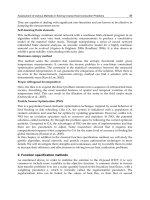Convection and Conduction Heat Transfer Part 3 pdf
Bạn đang xem bản rút gọn của tài liệu. Xem và tải ngay bản đầy đủ của tài liệu tại đây (5.59 MB, 30 trang )
18 Will-be-set-by-IN-TECH
×
Periodically Forced Natural Convection Through the Roof of an Attic-Shaped Building 19
×
6. Conclusions
× × × ×
20 Will-be-set-by-IN-TECH
× ×
7. Nomenclature
β
ν
ρ
κ
Δ
8. References
Periodically Forced Natural Convection Through the Roof of an Attic-Shaped Building 21
22 Will-be-set-by-IN-TECH
Convection and Conduction Heat Transfer
56
Forced convection is often encountered by engineers designing or analyzing heat
exchangers, pipe flow, and flow over flat plate at a different temperature than the stream
(the case of a shuttle wing during re-entry, for example). However, in any forced convection
situation, some amount of natural convection is always present. When the natural
convection is not negligible, such flows are typically referred to as mixed convection.
When analyzing potentially mixed convection, a parameter called the Richardson number
(Ri= Gr/ Re
2
) parametizes the relative strength of free and forced convection. The Richardson
number is the ratio of Grashof number and the square of the Reynolds number, which
represents the ratio of buoyancy force and inertia force, and which stands in for the
contribution of natural convection. When Ri>>1, natural convection dominates and when
Ri<<1, forced convection dominates and when Ri=1, mixed convection dominates.
The thermo-fluid fields developed inside the cavity depend on the orientation and the
geometry of the cavity. Reviewing the nature and the practical applications, the enclosure
phenomena can loosely be organized into two classes. One of these is enclosure heated from
the side which is found in solar collectors, double wall insulations, laptop cooling system
and air circulation inside the room and the another one is enclosure heated from below
which is happened in geophysical system like natural circulation in the atmosphere, the
hydrosphere and the molten core of the earth.
Nomenclature
h convective heat transfer coefficient (W/m
2
K)
q" Heat Flux (W/m
2
)
C
P
specific heat at constant pressure (J/kg K)
g gravitational acceleration (m/s
2
)
k thermal conductivity of the fluid (W/m K)
Nu Nusselt number, hW/k
Pr Prandtl number, ν/α
Gr Grashof number, gβΔTW
3
/ν
2
Re Reynolds number, U
0
W/ν
Ri Richardson number, Gr/Re
2
A Aspect Ratio, H/W
R length of the inclined sidewalls (m)
T temperature of the fluid, (°C)
u velocity component at x-direction (m/s)
U dimensionless velocity component at X-direction
v velocity component at y-direction (m/s)
V dimensionless velocity component at Y-direction
W length of the cavity, (m)
x distance along the x-coordinate
X distance along the non-dimensional x-coordinate
Y distance along the non-dimensional y-coordinate
Greak symbols
α thermal diffusivity of the fluid (m
2
/s)
β volumetric coefficient of thermal expansion (K
-1
)
γ inclination angle of the sidewalls of the cavity
Analysis of Mixed Convection in a Lid Driven Trapezoidal Cavity
57
θ dimensionless temperature ,(T
H
-T
C
)/ΔT
μ dynamic viscosity of the fluid (Pa s)
ν kinematic viscosity of the fluid (m
2
/s)
ρ density of the fluid (kg/m
3
)
Φ rotational angle of the cavity
Subscript
a average value
v value of cold temperature
c
H
value of hot temperature
1.1 Flow within enclosure
The flow within an enclosure consisting of two horizontal walls, at different temperatures, is
an important circumstance encountered quite frequently in practice. In all the applications
having this kind of situation, heat transfer occurs due to the temperature difference across
the fluid layer, one horizontal solid surface being at a temperature higher than the other. If
the upper plate is the hot surface, then the lower surface has heavier fluid and by virtue of
buoyancy the fluid would not come to the lower plate. Because in this case the heat transfer
mode is restricted to only conduction. But if the fluid is enclosed between two horizontal
surfaces of which the upper surface is at lower temperature, there will be the existence of
cellular natural convective currents which are called as Benard cells. For fluids whose
density decreases with increasing temperature, this leads to an unstable situation. Benard [1]
mentioned this instability as a “top heavy” situation. In that case fluid is completely
stationary and heat is transferred across the layer by the conduction mechanism only.
Rayleigh [2] recognized that this unstable situation must break down at a certain value of
Rayleigh number above which convective motion must be generated. Jeffreys [3] calculated
this limiting value of Ra to be 1708, when air layer is bounded on both sides by solid walls.
1.1.1 Tilted enclosure
The tilted enclosure geometry has received considerable attention in the heat transfer
literature because of mostly growing interest of solar collector technology. The angle of tilt
has a dramatic impact on the flow housed by the enclosure. Consider an enclosure heated
from below is rotated about a reference axis. When the tilted angle becomes 90º, the flow
and thermal fields inside the enclosure experience the heating from side condition. Thereby
convective currents may pronounce over the diffusive currents. When the enclosure rotates
to 180º, the heat transfer mechanism switches to the diffusion because the top wall is heated.
1.1.2 LID driven enclosure
Flow and heat transfer analysis in lid-driven cavities is one of the most widely studied
problems in thermo-fluids area. Numerous investigations have been conducted in the past
on lid-driven cavity flow and heat transfer considering various combinations of the imposed
temperature gradients and cavity configurations. This is because the driven cavity
configuration is encountered in many practical engineering and industrial applications.
Such configurations can be idealized by the simple rectangular geometry with regular
boundary conditions yielding a well-posed problem. Combined forced-free convection flow
in lid-driven cavities or enclosures occurs as a result of two competing mechanisms. The
Convection and Conduction Heat Transfer
58
first is due to shear flow caused by the movement of one of the walls of the cavity while the
second is due to buoyancy flow produced by thermal non homogeneity of the cavity
boundaries. Understanding these mechanisms is of great significance from technical and
engineering standpoints.
1.2 Application
Air-cooling is one of the preferred methods for the cooling of computer systems and other
electronic equipments, due to its simplicity and low cost. It is very important that such
cooling systems should be designed in the most efficient way and the power requirement
for the cooling should be minimized. The electronic components are treated as heat sources
embedded on flat surfaces. A small fan blows air at low speeds over the heat sources. This
gives rise to a situation where the forced convection due to shear driven flow and the
natural convection due to buoyancy driven flow are of comparable magnitude and the
resulting heat transfer process is categorized as mixed convection. Mixed convection flow
and heat transfer also occur frequently in other engineering and natural situations. One
important configuration is a lid-driven (or shear- driven) flow in a differentially
heated/cooled cavity, which has applications in crystal growth, flow and heat transfer in
solar ponds [5], dynamics of lakes [6], thermal-hydraulics of nuclear reactors [7], industrial
processes such as food processing, and float glass production [8]. The interaction of the
shear driven flow due to the lid motion and natural convective flow due to the buoyancy
effect is quite complex and warrants comprehensive analysis to understand the physics of
the resulting flow and heat transfer process.
1.3 Motivation behind the selection of problem
Two dimensional steady, mixed convection heat transfers in a two-dimensional trapezoidal
cavity with constant heat flux from heated bottom wall while the isothermal moving top
wall has been studied numerically. The present study is based on the configuration of Aydin
and Yang [27] where the isothermal heat source at the bottom wall is replaced by a constant
flux heat source, which is physically more realistic. The main attribute for choosing the
trapezoidal shape cavity is to enhance the heat transfer rate as it could be said intuitionally
due to its extended cold top surface. The inclination angle of the sidewalls of the trapezoid
has been changed (30°, 45° and 60°) to get the maximum heat transfer in terms of maximum
Nusselt number. Then the trapezoid has been rotated (30°, 45° and 60°) and the results have
been studied. The tilted position of the enclosure shows a significant influence on the heat
transfer. Results are obtained for both the aiding and opposing flow conditions by changing
the direction of the lid motion. This study includes additional computations for cavities at
various aspect ratios, A, ranging from 0.5 to 2 and their effects on the heat transfer process is
analyzed in terms of average Nusselt number. Contextually the present study will focus on
the computational analysis of the influence of inclination angle of the sidewalls of the cavity,
rotational angle of the cavity, Aspect ratio, direction of the lid motion and Richardson number.
1.4 Main objectives of the work
The investigation is carried out in a two dimensional lid driven trapezoidal enclosure filled
with air. The inclined side walls are kept adiabatic and the bottom wall of the cavity is kept
at uniform heat flux. The cooled top wall having constant temperature will move with a
constant velocity. The specific objectives of the present research work are as follows:
Analysis of Mixed Convection in a Lid Driven Trapezoidal Cavity
59
a. To study the variation of average heat transfer in terms of Nusselt number with the
variation of Richardson number at different aspect ratios of the rectangular enclosure
and compare it with the established literature.
b. To find out the optimum configuration by changing the inclination angle of the side
walls of the trapezoidal cavity by analyzing the maximum heat transfer.
c. To study the variation of average heat transfer in terms of Nusselt number with the
variation of Richardson number of the optimum trapezoidal cavity.
d. To study the variation of average heat transfer in terms of Nusselt number at different
aspect ratios of the optimum trapezoidal cavity.
e. To study the variation of average heat transfer in terms of Nusselt number with the
variation of Richardson number at different aspect ratios of the optimum trapezoidal
enclosure by changing the rotation angle for both aiding and opposing flow conditions
f. To analyze the flow pattern inside the trapezoidal enclosures in terms of Streamlines
and isotherms.
2. Literature review
There have been many investigations in the past on mixed convective flow in lid-driven
cavities. Many different configurations and combinations of thermal boundary conditions
have been considered and analyzed by various investigators. Torrance et al. [9] investigated
mixed convection in driven cavities as early as in 1972. Papaniclaou and Jaluria [10-13]
carried out a series of numerical studies to investigate the combined forced and natural
convective cooling of heat dissipating electronic components, located in rectangular
enclosures, and cooled by an external through flow of air. The results indicate that flow
patterns generally consists of high of low velocity re-circulating cells because of buoyancy
forces induced by the heat source. Koseff and Street [14] studied experimentally as well as
numerically the recirculation flow patterns for a wide range of Reynolds (Re) and Grashof
(Gr) numbers. Their results showed that the three dimensional features, such as corner
eddies near the end walls, and Taylor- Gortler like longitudinal vortices, have significant
effects on the flow patterns for low Reynolds numbers. Khanafer and Chamakha [15]
examined numerically mixed convection flow in a lid-driven enclosure filled with a fluid-
saturated porous medium and reported on the effects of the Darcy and Richardson numbers
on the flow and heat transfer characteristics.
G. A. Holtzman et. al [16] have studied laminar natural convection in isosceles triangular
enclosures heated from below and symmetrically cooled from above. This problem is
examined over aspect ratios ranging from 0.2 to 1.0 and Grashoff numbers from 10
3
to 10
5
.
Its is found that a pitchfork bifurcation occurs at a critical Grashoff number for each of the
aspect ratios considered, above which the symmetric solutions are unstable to finite
perturbations and asymmetric solutions are instead obtained. Results are presented
detailing the occurance of the pitchfork bifurcation in each of the aspect ratios considered,
and the resulting flow patterns are described. A flow visualization study is used to validate
the numerical observations. Difference in local values of the Nusselt number between
asymmetric and symmetric solutions are found to be more than 500 percent due to the
shifting of the buoyancy- driven cells. The phenomenon of natural convection in trapezoidal
enclosures where upper and lower walls are not parallel, in particular a triangular
geometry, is examined by H. Asan, L. Namli [17] over a parameter domain in which the
aspect ratio of the enclosure ranges from 0.1 to 1.0, the Rayleigh number varies between 10
2
Convection and Conduction Heat Transfer
60
to 10
5
and Prandtl number correspond to air and water. It is found that the numerical
experiments verify the flow features that are known from theoretical asymptotic analysis of
this problem (valid for shallow spaces) only over a certain range of the parametric domain.
Moallemi and Jang [18] numerically studied mixed convective flow in a bottom heated
square driven cavity and investigated the effect of Prandtl number on the flow and heat
transfer process. They found that the effects of buoyancy are more pronounced for higher
values of Prandtl number. They also derived a correlation for the average Nusselt number in
terms of the Prandtl number, Reynolds number, and Richardson number. Mohammad and
Viskanta [19] performed numerical investigation and flow visualization study on two and
three-dimensional laminar mixed convection flow in a bottom heated shallow driven cavity
filled with water having a Prandtl number of 5.84. They concluded that the lid motion
destroys all types of convective cells due to heating from below for finite size cavities. They
also implicated that the two-dimensional heat transfer results compare favorably with those
based on a three-dimensional model for Gr/Re< 1. Later, Mohammad and Viskanta [20]
experimentally and numerically studied mixed convection in shallow rectangular bottom
heated cavities filled with liquid Gallium having a low Prandtl number of 0.022. They found
that the heat transfer rate is rather insensitive to the lid velocity and an extremely thin shear
layer exists along the major portion of the moving lid. The flow structure consists of an
elongated secondary circulation that occupies a third of the cavity.
Mansour and Viskanta [21] studied mixed convective flow in a tall vertical cavity where
one of the vertical sidewalls, maintained at a colder temperature than the other, was moving
up or downward thus assisting or opposing the buoyancy. They observed that when shear
assisted the buoyancy a shear cell developed adjacent to the moving wall while the
buoyancy cell filled the rest of the cavity. When shear opposed buoyancy, the heat transfer
rate reduced below that for purely natural convection. Iwatsu et al. [22] and Iwatsu and
Hyun [23] conducted two-dimensional and three-dimensional numerical simulation of
mixed convection in square cavities heated from the top moving wall. Mohammad and
Viskanta [24] conducted three-dimensional numerical simulation of mixed convection in a
shallow driven cavity filled with a stably stratified fluid heated from the top moving wall
and cooled from below for a range of Rayleigh number and Richardson number.
Prasad and Koseff [25] reported experimental results for mixed convection in deep lid-
driven cavities heated from below. In a series of experiments which were performed on a
cavity filled with water, the heat flux was measured at different locations over the hot cavity
floor for a range of Re and Gr. Their results indicated that the overall (i.e. area-averaged)
heat transfer rate was a very weak function of Gr for the range of Re examined (2200 < Re <
12000). The data were correlated by Nusselt number vs Reynolds number, as well as Stanton
number vs Reynolds number relations.
They observed that the heat transfer is rather insensitive to the Richardson number. Hsu and
Wang [26] investigated the mixed convective heat transfer where the heat source was
embedded on a board mounted vertically on the bottom wall at the middle in an enclosure.
The cooling air flow enters and exits the enclosure through the openings near the top of the
vertical sidewalls. The results show that both the thermal field and the average Nusselt
number depend strongly on the governing parameters, position of the heat source, as well
as the property of the heat-source-embedded board.
Aydin and Yang [27] numerically studied mixed convection heat transfer in a two-
dimensional square cavity having an aspect ratio of 1. In their configuration the isothermal
sidewalls of the cavity were moving downwards with uniform velocity while the top wall
Analysis of Mixed Convection in a Lid Driven Trapezoidal Cavity
61
was adiabatic. A symmetrical isothermal heat source was placed at the otherwise adiabatic
bottom wall. They investigated the effects of Richardson number and the length of the heat
source on the fluid flow and heat transfer. Shankar et al. [28] presented analytical solution
for mixed convection in cavities with very slow lid motion. The convection process has been
shown to be governed by an inhomogeneous biharmonic equation for the stream function.
Oztop and Dagtekin [29] performed numerical analysis of mixed convection in a square
cavity with moving and differentially heated sidewalls. Sharif [30] investigates heat transfer
in two-dimensional shallow rectangular driven cavity of aspect ratio 10 and Prandtl number
6.0 with hot moving lid on top and cooled from bottom. They investigated the effect of
Richardson number and inclination angle. G. Guo and M. A. R. Sharif [31] studied mixed
convection in rectangular cavities at various aspect ratios with moving isothermal sidewalls
and constant heat source on the bottom wall. They plotted the streamlines and isotherms for
different values of Richardson number and also studied the variation of the average Nu and
maximum surface temperature at the heat source with Richardson number with different
heat source length. They simulated streamlines and isotherms for asymmetric placements of
the heat source and also the effects of asymmetry of the heating elements on the average Nu
and the maximum source length temperature.
3. Physical model
The physical model considered here is shown in figure 1 and 2, along with the important
geometric parameters. It consists of a trapezoidal cavity filled with air, whose bottom wall
and top wall are subjected to hot T
H
and cold T
C
temperatures respectively while the side
walls are kept adiabatic. Two cases of thermal boundary conditions for the top moving wall
have been considered here. The first case is (figure 1) when the moving cold wall is moving
in the positive x direction (opposing flow condition). In that case the shear flow caused by
moving top wall opposes the buoyancy driven flow caused by the thermal non-homogeneity
of the cavity boundaries. The second case is (figure 2) when the moving cold wall is moving
in the negative x direction (aiding flow condition). In that case the shear flow assists the
buoyancy flow. The cavity height is H, width of the bottom hot wall is W, is inclined at
angle Ф with the horizontal reference axis. γ is the inclination angle of the sidewalls of the
cavity. The flow and heat transfer phenomena in the cavity are investigated for a series of
Richardson numbers (Ri), aspect ratio (A=H/W), rotation angle of the cavity Ф.
Fig. 1. Schematic diagram of the physical system considering opposing flow condition
Convection and Conduction Heat Transfer
62
Fig. 2. Schematic diagram of the physical system considering aiding flow condition
3.1 Mathematical model
Using the Boussinesq approximation and neglecting the viscous dissipation effect and
compressibility effect the dimensionless governing equations for two dimensional laminar
incompressible flows can be written as follows:
0=
∂
∂
+
∂
∂
Y
V
X
U
(1)
⎟
⎟
⎠
⎞
∂
∂
+
⎜
⎜
⎝
⎛
∂
∂
+
∂
∂
−=
∂
∂
+
∂
∂
2
2
2
2
Re
1
Y
U
X
U
X
P
Y
U
V
X
U
U
(2)
θ
22
2
2
2
Re
Re
1 Gr
Y
V
X
V
Y
P
Y
V
V
X
V
U +
⎟
⎟
⎠
⎞
∂
∂
+
⎜
⎜
⎝
⎛
∂
∂
+
∂
∂
−=
∂
∂
+
∂
∂
(3)
⎟
⎟
⎠
⎞
∂
∂
+
⎜
⎜
⎝
⎛
∂
∂
=
∂
∂
+
∂
∂
2
2
2
2
PrRe
1
YX
Y
V
X
U
θθθθ
(4)
The dimensionless variables are as follows:
X=x/W, Y=y/W, θ=(T
H
-T
C
)/ΔT, ΔT=q"W/k, U=u/U
0
, V=v/ U
0,
P=p/ρU
o
2
The dimensionless parameters, appearing in Eqs. (1)-(4) are Reynolds number Re= U
0
W/ν ,
the Prandtl number Pr=ν/α, the Grashof number
3
2
gTL
Gr
β
ν
∇
=
. The ratio of Gr/Re
2
is the
mixed convection parameter and is called Richardson number Ri and is a measure of the
relative strength of the natural convection and forced convection for a particular problem. If
Ri<<1 the forced convection is dominant while if Ri>> 1, then natural convection is
dominant. For problems with Ri~1 then the natural convection effects are comparable to the
forced convection effects.
The boundary conditions for the present problem are specified as follows:
Top wall: U=U
0
, V=0, θ=0
Analysis of Mixed Convection in a Lid Driven Trapezoidal Cavity
63
Bottom wall: U=V=0, θ=1
Right and Left wall: U=V=0,
0X
θ
∂
∂=
Non-dimensional heat transfer parameter Nusselt number is stated as:
3.2 Numerical method
Firstly the problem is defined as a two dimensional enclosure. Control Volume based finite
volume method (FVM) is to be used to discretize the governing differential equations. The
pressure- velocity coupling in the governing equations is achieved using the well known
SIMPLE method for numerical computations. The set of governing equations are to be
solved sequentially. A second order upwind differencing scheme is to be used for the
formulation of the coefficients in the finite-volume equations. As the sides of the trapezoidal
cavity are not parallel, the present numerical techniques will descretize the computational
domain into unstructured triangular elements.
In order to obtain the grid independence solution, a grid refinement study is performed for
the trapezoidal cavity (A=1) under constant heat flux condition keeping, Re=400, Pr=0.71,
Ri= 1.0.n It is found in figure 3 that 5496 regular nodes are sufficient to provide accurate
results. This grid resolution is therefore used for all subsequent computations for A≤1. For
taller cavities with A>1, a proportionately large number of grids in the vertical direction is
used.
6
7
8
9
1000 2000 3000 4000 5000 6000 7000
Number of Nodes
Nu
av
Fig. 3. Grid sensitivity test for trapezoidal cavity at Ri=1.0, Re=400 and A=1
The convergence criterion was defined by the required scaled residuals to decrease 10⎯
5
for
all equations except the energy equations, for which the criterion is 10⎯
8
.
The computational procedure is validated against the numerical results of Iwatsu et el.[22]
for a top heated moving lid and bottom cooled square cavity filled with air (Pr=0.71). A
60×60 mesh is used and computations are done for six different Re and Gr combinations.
Comparisons of the average Nusselt number at the hot lid are shown in Table 1. The general
Convection and Conduction Heat Transfer
64
agreement between the present computation and that of Iwatsu et al. [22] is seen to be very
well with a maximum discrepancy of about 3.9%.
Re
Gr= 10
2
Gr= 10
4
Gr= 10
6
Present Iwatsu
et al.
Diff.
%
Present Iwatsu
et al.
Diff. % Present Iwatsu
et al.
Diff. %
400 3.97 3.84 3.3 3.75 3.62 3.5 1.18 1.22 3.2
1000 6.25 6.33 1.2 6.32 6.29 0.47 1.70 1.77 3.9
Table 1. Comparison of the computed average Nusselt number at the hot plate
The computational procedure has also been validated against the numerical results of Guo
and Sharif [31] shown in the figure 4.
Fig. 4. Variation of the average Nusselt number with different aspect ratio at Ri=10, Re=100
and ε =0.6
Figure 4, reveals that the Average Nusselt numbers in the present study have excellent
agreement with those obtained by Guo and Sharif [31] having a maximum discrepancy of
about 2.3% Therefore, it can be concluded that the numerical code used in this analysis can
solve the present problem with reasonable agreement.
4. Results and disscussion
Numerical results are presented in order to determine the effects of the inclination angle of
the side walls, Richardson number Ri, Reynolds number Re, Aspect ratio A, the rotational
angle of the cavity Ф on mixed convection flow in trapezoidal enclosure. The inclination
angle of the sidewalls of the trapezoidal enclosure has been changed from 30º to 60º with an
interval of 15º. The values of Richardson number varies from 0.1 to 10, Aspect ratio, A
changes from 0.5 to 2.0 taking Rotational angle 30º, 45 º, 60º for two different Reynolds
numbers 400 and 600.
0
1
2
3
4
5
6
7
8
9
10
0.5 1 1.5 2
G. Guo at Ri=10
Present computation at Ri=10
G. Guo at Ri=0.1
Present computation at Ri=0.1
A
Nu
Analysis of Mixed Convection in a Lid Driven Trapezoidal Cavity
65
4.1 Effect of inclination angle
In this study the effect of inclination angle of the adiabatic sidewalls has been observed first.
The inclination angle of the side walls has been changed to 30º, 45 º and 60º. The Richardson
number has been changed from 0.1 to 10. The optimum inclination angle has been selected
based on the average Nusselt number which is a non dimensional parameter that indicates
the rate of heat transfer between the hot and cold walls. The results are obtained both for
Re=400 and Re=600.
Figure 5-7 reveals the impact of varying inclination angles of the sidewalls of the trapezoidal
cavity. These figures show the contours of streamlines and isotherms at different Richardson
numbers. For small values of Ri number, it can be seen that the shear effect due to the
movement of the top wall is dominant. The fluid flow is characterized by a primary re-
circulating eddy of the size of the cavity generated by the movement of the top lid. The
isothermal contour maps are clustered near the bottom and top walls resulting in steep
temperature gradient there. In each case as the Richardson number increases the convection
current becomes more dominant resulting in stronger flow field. Again at γ=45º (figure 6),
the flow field is stronger than the γ=30º and γ=60º (figure 5 and figure 7), which is an
indication of better heat transfer. The isothermal plots also complies with the flow field,
showing minimum value of the maximum isotherms at γ=45º.
From figure 8-9 the average value of the Nusselt number with respect to the Richardson
number has been plotted. Here it can be seen that Nusselt number at γ=45º dominates the
other two cases i.e. γ=30º and γ=60º, showing better heat transfer. So it is clearly visible that
trapezoid having the inclination angle γ=45º gives better heat transfer and consequently it
can be taken as the optimum inclination angle.
4.2 Effect of rotational angle, Φ
Next the effect of rotational angle, Φ has been studied. When studying the effect of
rotational angel, two distinct cases have been taken into consideration. They are aiding and
opposing flow condition. The first one is when the shear driven flow opposes the convective
flow and in that case the top moving lid is moving in the positive direction at a specified
rotational angle [figure 1]. The second condition is the aiding flow condition where the
shear driven flow aids the natural convective flow and the moving top lid moves in the
opposite direction unlike the first case [figure 2]. Both these cases have been studied for a
rotational angle for Φ=30º, 45º and 60º and their heat transfer characteristics has been
studied in terms of streamlines and isothermal plots.
Unlike Φ=0º, when the buoyancy is acting only in the y direction, as the rotational angle Φ
changes, the flow field changes significantly. In opposing flow condition the shear driven
flow opposes the natural convective flow, At low Richardson number (Ri<1)the forced
convection is dominating, creating a single circulation at the right corner of the top moving
lid [figure 10-12].
As the Richardson number increases (Ri>1), natural convection becomes dominating
creating a large circulation at the bottom of the cavity. This large circulation causing by
natural convection goes bigger and stronger as Ri number increases as well as squeezes the
upper circulation, resulting an opposing effect. If we observe the isothermal plots, it changes
accordingly with streamlines. As Ri
number increases, the isothermal lines changes
significantly indicating that the convection is the dominating heat transfer for the specified
case. The shear driven circulation at the upper right side becomes smaller and smaller as the
Ri number increases because of dominating natural convection.
Convection and Conduction Heat Transfer
66
R
i
= 0.1
R
i
= 1
R
i
= 5
R
i
= 10
Fig. 5. Contours of streamlines and isotherms at Re=400, A=1.0 and γ=30°
Analysis of Mixed Convection in a Lid Driven Trapezoidal Cavity
67
R
i
= 0.1
R
i
= 5
R
i
= 10
Fig. 6. Contours of streamlines and isotherms at Re=400, A=1.0 and γ=45°
Convection and Conduction Heat Transfer
68
R
i
= 0.1
R
i
= 1
R
i
= 5
R
i
= 10
Fig. 7. Contours of streamlines and isotherms at Re=400, A=1.0 and γ=60°
Analysis of Mixed Convection in a Lid Driven Trapezoidal Cavity
69
1
2
3
4
5
6
7
8
9
10
0246810
Nu
av
Ri
Re=400
γ=30º
γ=45º
γ=60º
Fig. 8. Average Nusselt number, Nu
av
vs Richardson number at Re=400, A=1
1
3
5
7
9
11
13
0246810
Nu
av
Ri
Re=600
γ
= 30º
γ = 45º
γ = 60º
Fig. 9. Average Nusselt number, Nu
av
vs Richardson number at Re=600, A=1
Convection and Conduction Heat Transfer
70
R
i
= 0.1
R
i
= 1
R
i
= 5
R
i
= 10
Fig. 10. Contours of streamlines and isotherms at Re=400, A=0.5 and Ф=30°, opposing flow
Analysis of Mixed Convection in a Lid Driven Trapezoidal Cavity
71
R
i
= 0.1
R
i
= 1
R
i
= 5
R
i
= 10
Fig. 11. Contours of streamlines and isotherms at Re=400, A=1 and Ф=30°, opposing flow
Convection and Conduction Heat Transfer
72
R
i
= 1
R
i
= 1
R
i
= 1
R
i
= 1
Fig. 12. Contours of streamlines and isotherms at Re=400, A=1.5 and Ф=30°, opposing flow
Analysis of Mixed Convection in a Lid Driven Trapezoidal Cavity
73
R
i
= 0.1
R
i
= 1
R
i
= 5
R
i
= 10
Fig. 13. Contours of streamlines and isotherms at Re=400, A=1 and Ф=45°, aiding flow









